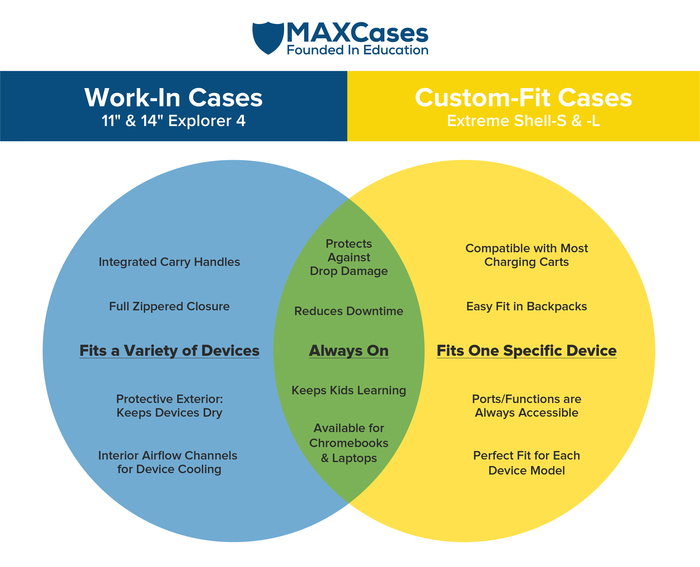
By Cynthia Kater, MAXCases Marketing Manager
Ever wondered about how laptop cases are categorized? In the abstract, it doesn’t make for great dinner conversation. The distinctions take on a new light, however, when faced with determining the best choice for your organization or classroom. Back in the day, briefcase-like bags were the most widely-available option. Today, device-specific custom-fit cases and universal work-in cases are the most popular choices.
We invite you to read on and learn about which of these distinctly-different protective solutions may be the best fit for your organization. (We even include a handy VEN diagram.)
Bags and Sleeves
The defining characteristic of traditional bags and sleeves is that the users must take the device out of the bag to use it. Designed to meet a wide range of needs, from ultra-slim sleeves to fully-loaded Esports backpacks, they’re great for careful users, and not recommended for younger students. By contrast, both custom-fit and work-in cases offer “always on” solutions that provide 24/7 protection.
The Custom-Fit Case
This one goes by many different names. Some call them “hard shell” cases, others go by the manufacturing method and call them “injection molded.” At MAXCases, we like “custom-fit” because it tells it like it is: These cases are designed to the exact specifications of a given device model.
Custom-fit cases provide a perfect fit for their specific device, be it an iPad, Chromebook or MacBook. This means that users will always have easy access to the device’s buttons, ports, and plug openings, and the camera will be exposed and functional. These types of cases ensure that all device functions are accessible and usable at all times, and they provide a snug, secure fit.
The Work-In Case
These are handy cases that provide both protection and the convenience of a carrying case. The name distinguishes these cases from standard “briefcase-style” carrying bags (or sleeves with handles), which require the user to take the device out of the bag or sleeve to use.
Work-in-cases protect devices 24/7. This is because – while they may look like a carrying bag – the user never needs to remove the device from the case. They simply zip it open, set it on the worksurface and – voila! – they are ready to work – while the device stays safe and sound within the case.
Diagraming the Differences
Now that you’re acquainted with the basics, we’ll break down the benefits of each type of case, looking at which features make them suited to particular usage needs.
Device Protection
The number one reason cases exist is to protect devices. MAXCases custom-fit cases for Chromebooks/laptops and iPads/tablets tackle this task with rugged bumpers and enhanced corners that absorb and dissipate shock vibrations caused by bumps and drops. Depending on the design, the back and/or front of the device is covered by a clear, rigid compound plastic, which protects against dings, scratches and dirt. Custom-fit cases for iPad include built-in, commercial-grade screen protectors.
Our Explorer work-in cases protect Chromebooks and laptops from drops with a sturdy, rigid frame and shock-absorbing molded interior. The soft-touch lining protects against scratches while the ballistic nylon exterior guards against damage from spills, rain and mishaps with puddles.
Cost Savings
You know this hurdle: Having sufficient budget to meet your school or districts’ many (many) needs. Both work-in and custom-fit cases do their part to help, by safeguarding device investments and reducing damage and repair/helpdesk/IT costs, as well as by reducing the intangible costs of lost learning time and added stress on students and families when devices are out of commission.
Versatility
Work-in cases accommodate a range of devices and offer greater flexibility than their custom-fit counterparts. This type of case is ideal for school systems that have, or anticipate having, several different device models in circulation – an increasingly common circumstance that began even before the pandemic brought on unprecedented supply-chain challenges. Work-in cases provide the versatility in sizing that enables schools to adapt to supply uncertainties, as well as to modify device models based on best pricing and availability.
Features
Work-in cases are distinguished by their integrated carrying capabilities, making them ideal for students that need to carry their device between classes, or who frequently take their device home. By contrast, custom-fit cases – which MAXCases designs to fit standard charging carts – are often the best choice when devices are kept at school.
Both work-in cases and custom-fit cases provide always-on protection against damage, which helps schools reduce costs, and keep kids learning. Work-in cases are an outstanding option for school districts that need to manage a mixed group of multiple brands and/or device models. MAXCases Explorer 4 Work-in Case is available in 11-inch and 14-inch sizes to accommodate most standard Chromebooks and laptops. Schools that are standardized on one or two models may prefer custom-fit cases that provide easy access to all functions, are compatible with standard charging carts, and fit easily into student backpacks.
While bags and sleeves have their place, they cannot provide the around-the-clock security of work-in and custom-fit cases. Think about it. Would you want a K12-aged student to use your smartphone without a case? Probably not. Whether custom-fitted, work-in – or a combination of both – is best suited for your environment, investing in these 24/7 cases will save you time, money and hassles in the long run.


